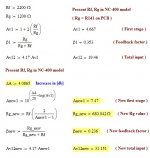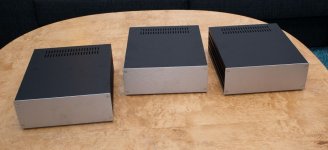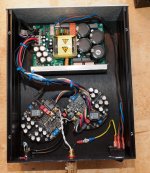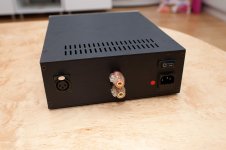Thanks again
.
R141=Rg=1.2k
Rf=2.2k
for the NC-400 model
that is what I found in one of the Brunos post
Yes There is no need to change the Rf i was just curious
Thanks
now it is clear
I just need +3db additional gain...
.
R141=Rg=1.2k
Rf=2.2k
for the NC-400 model
that is what I found in one of the Brunos post
Yes There is no need to change the Rf i was just curious
Thanks
now it is clear
I just need +3db additional gain...
I just need +3db additional gain...
Just be aware that increasing gain lowers the feedback. While Bruno has commented that increasing feedback is OK, I think you might be in somewhat uncharted waters if you actually lower the feedback from the nominal.
Very interested in hearing your experiences if you try it.
Hi,
Quick question. Can someone point me toward the connector for J1 on the SMPS? I have looked for item # JST-B7B-EHA on Digikey, with no luck. This looks like it, but not the correct item #. I seem to have thrown out the ones that came with my units and need them now.
Thank you
Quick question. Can someone point me toward the connector for J1 on the SMPS? I have looked for item # JST-B7B-EHA on Digikey, with no luck. This looks like it, but not the correct item #. I seem to have thrown out the ones that came with my units and need them now.
Thank you
Hi,
Quick question. Can someone point me toward the connector for J1 on the SMPS? I have looked for item # JST-B7B-EHA on Digikey, with no luck. This looks like it, but not the correct item #. I seem to have thrown out the ones that came with my units and need them now.
Thank you
Digi-Key Part Number
455-1005-ND - Housing.
455-1042-1-ND Crimp
While we are at it, would someone know the exact reference of the female crimp terminal to use with the microfit molex connector 43025-1200 ?
I think it is the 43030, but several version exists:
View List
What is the AWG of the wire?
I would like to fit 2 (or myabe even 3) wires per connector, so if the original AWG is 24, 2 of them should fit no problem in the 20-24 AWG model...
Also, do you know if special tools are required to assembled those crimps, or will a simple crimp tool be sufficient?
I think it is the 43030, but several version exists:
View List
What is the AWG of the wire?
I would like to fit 2 (or myabe even 3) wires per connector, so if the original AWG is 24, 2 of them should fit no problem in the 20-24 AWG model...
Also, do you know if special tools are required to assembled those crimps, or will a simple crimp tool be sufficient?
My 3 monoblocks with bridged nc400 and SMPS1200A400, built by my friend Georg.
We have compared them against the standard nc400+SMPS600 in a dual-mono config today. The bridged ones sounds much more "alive", and they are not even broken in. The standard ones sounds flatter. Less dynamics.
The monoblocks has version 4 of nc400. The dual-mono has version 3. What was the changes made in version 4?
We have compared them against the standard nc400+SMPS600 in a dual-mono config today. The bridged ones sounds much more "alive", and they are not even broken in. The standard ones sounds flatter. Less dynamics.
The monoblocks has version 4 of nc400. The dual-mono has version 3. What was the changes made in version 4?
Attachments
We have compared them against the standard nc400+SMPS600 in a dual-mono config today. The bridged ones sounds much more "alive", and they are not even broken in. The standard ones sounds flatter. Less dynamics.
Did you do the comparison as a double-blind ABX, or as a sighted subjective evaluation?
My 3 monoblocks with bridged nc400 and SMPS1200A400, built by my friend Georg.
We have compared them against the standard nc400+SMPS600 in a dual-mono config today. The bridged ones sounds much more "alive", and they are not even broken in. The standard ones sounds flatter. Less dynamics.
The monoblocks has version 4 of nc400. The dual-mono has version 3. What was the changes made in version 4?
I am missing the cap across the output terminals!
Did you do the comparison as a double-blind ABX, or as a sighted subjective evaluation?
We just listened to the same song with subjectively the same volume.
I am not claiming its the truth, just what we experienced 🙂
The bridged one also sounded a bit warmer.
I am missing the cap across the output terminals!
Why? It is there! A little small red wima cap.
Did you do the comparison as a double-blind ABX, or as a sighted subjective evaluation?
...or level matched within 0.1 dB?
About level matching. Is there a finish product on the market where this is can be easily done as well as connecting two units and switching with a button?
Or PM if someone would like to build something like this for me. 🙂
Or PM if someone would like to build something like this for me. 🙂
Its easy if you can individually adjust the level going to the amps: simply connect a speaker between the + terminals of both amps, play music and adjust the level of the amps until you have no sound from the speaker.
I have had them running all night today playing low volume. The cases are very hot. I can hold my hand on them without pain, but it is hotter than anything I have had before.
I will check if Hifi2000 sells more ventilated top covers to this case (Galaxy Maggiorato with aluminium top/bottom)
The internal regulators are working in the nc400 because I do not have the smps600. So they are dissipating more heat than the in normal case.
Without the top cover it was not running hot at all.
Any other advice what I can/should do? I know theat many class-A amplifiers are running very hot, maybe it is ok?
I will check if Hifi2000 sells more ventilated top covers to this case (Galaxy Maggiorato with aluminium top/bottom)
The internal regulators are working in the nc400 because I do not have the smps600. So they are dissipating more heat than the in normal case.
Without the top cover it was not running hot at all.
Any other advice what I can/should do? I know theat many class-A amplifiers are running very hot, maybe it is ok?
Any other advice what I can/should do? I know theat many class-A amplifiers are running very hot, maybe it is ok?
The hotter you run electronics, the sooner they fail, so ventilation holes would be a good idea.
Rajapruk,
Interesting observations on the bridging.
Regarding the heat, then how about making a small VDR supply. You shouldn´t need more than a small 12 to 15 VAC coil, a bridge and a small cap say 2200uF. Then use the negative HV supply as reference and you should have the 17-21 VDC you need for the VDR. It should save you half the heat dissipation form the modules and maybe that could also bring other improvements too 🙂
Best,
Interesting observations on the bridging.
Regarding the heat, then how about making a small VDR supply. You shouldn´t need more than a small 12 to 15 VAC coil, a bridge and a small cap say 2200uF. Then use the negative HV supply as reference and you should have the 17-21 VDC you need for the VDR. It should save you half the heat dissipation form the modules and maybe that could also bring other improvements too 🙂
Best,
strange.. I had my ncore at a DIY gathering last WE, and even at elevated music levels the cabinets were lukewarm at most. (standard aluminium Hifi 2000 slimline cabinets, ncores just mounted on the bottom)I have had them running all night today playing low volume. The cases are very hot. .
strange.. I had my ncore at a DIY gathering last WE, and even at elevated music levels the cabinets were lukewarm at most. (standard aluminium Hifi 2000 slimline cabinets, ncores just mounted on the bottom)
Henkjan,
I think the point here is that the external VDR is not used which roughly doubles the standby heat dissipation of the ncore modules. Playing music loud or not makes close to no difference as you have very good efficiency (probably > 90%) when neglecting the standby consumption hereunder the internal VDR (5W per module).
I don´t think the bridge configuration should make any noticeable difference on the heat dissipation form class D amps although it usually do on other classes of operation...
- Status
- Not open for further replies.
- Home
- Amplifiers
- Class D
- Hypex Ncore




